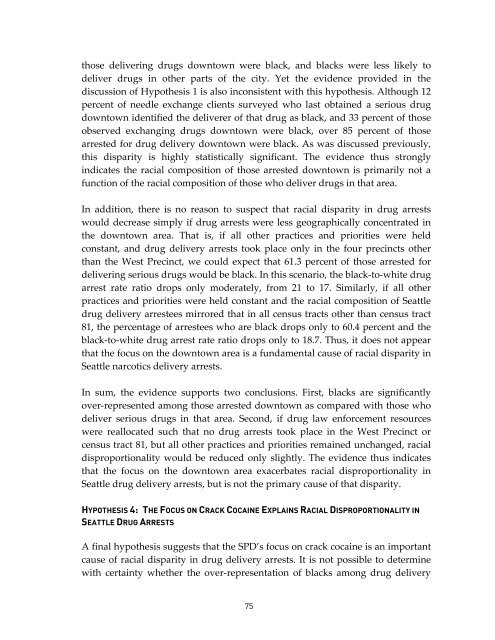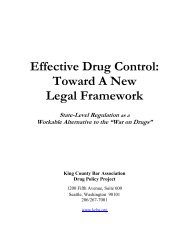RACE AND THE ENFORCEMENT OF DRUG DELIVERY LAWS IN ...
RACE AND THE ENFORCEMENT OF DRUG DELIVERY LAWS IN ...
RACE AND THE ENFORCEMENT OF DRUG DELIVERY LAWS IN ...
You also want an ePaper? Increase the reach of your titles
YUMPU automatically turns print PDFs into web optimized ePapers that Google loves.
those delivering drugs downtown were black, and blacks were less likely to<br />
deliver drugs in other parts of the city. Yet the evidence provided in the<br />
discussion of Hypothesis 1 is also inconsistent with this hypothesis. Although 12<br />
percent of needle exchange clients surveyed who last obtained a serious drug<br />
downtown identified the deliverer of that drug as black, and 33 percent of those<br />
observed exchanging drugs downtown were black, over 85 percent of those<br />
arrested for drug delivery downtown were black. As was discussed previously,<br />
this disparity is highly statistically significant. The evidence thus strongly<br />
indicates the racial composition of those arrested downtown is primarily not a<br />
function of the racial composition of those who deliver drugs in that area.<br />
In addition, there is no reason to suspect that racial disparity in drug arrests<br />
would decrease simply if drug arrests were less geographically concentrated in<br />
the downtown area. That is, if all other practices and priorities were held<br />
constant, and drug delivery arrests took place only in the four precincts other<br />
than the West Precinct, we could expect that 61.3 percent of those arrested for<br />
delivering serious drugs would be black. In this scenario, the black-to-white drug<br />
arrest rate ratio drops only moderately, from 21 to 17. Similarly, if all other<br />
practices and priorities were held constant and the racial composition of Seattle<br />
drug delivery arrestees mirrored that in all census tracts other than census tract<br />
81, the percentage of arrestees who are black drops only to 60.4 percent and the<br />
black-to-white drug arrest rate ratio drops only to 18.7. Thus, it does not appear<br />
that the focus on the downtown area is a fundamental cause of racial disparity in<br />
Seattle narcotics delivery arrests.<br />
In sum, the evidence supports two conclusions. First, blacks are significantly<br />
over-represented among those arrested downtown as compared with those who<br />
deliver serious drugs in that area. Second, if drug law enforcement resources<br />
were reallocated such that no drug arrests took place in the West Precinct or<br />
census tract 81, but all other practices and priorities remained unchanged, racial<br />
disproportionality would be reduced only slightly. The evidence thus indicates<br />
that the focus on the downtown area exacerbates racial disproportionality in<br />
Seattle drug delivery arrests, but is not the primary cause of that disparity.<br />
HYPO<strong>THE</strong>SIS 4: <strong>THE</strong> FOCUS ON CRACK COCA<strong>IN</strong>E EXPLA<strong>IN</strong>S RACIAL DISPROPORTIONALITY <strong>IN</strong><br />
SEATTLE <strong>DRUG</strong> ARRESTS<br />
A final hypothesis suggests that the SPD’s focus on crack cocaine is an important<br />
cause of racial disparity in drug delivery arrests. It is not possible to determine<br />
with certainty whether the over-representation of blacks among drug delivery<br />
75

















